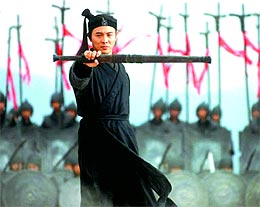Calligraphy and Painting
Chinese characters evolved from pictures and signs, and the Chinese art of calligraphy developed naturally from its unique writing system. Through the ages, great calligraphers developed representative calligraphic styles of their times. The love of calligraphy is deeply ingrained in Chinese scholars, and has been handed down to the present day.
The roots of Chinese painting can be traced back to paintings on Neolithic pottery six or seven thousand years ago. Since similar tools and lines were used for the earliest painting and writing, painting is said to have the same origin as calligraphy. Chinese painting usually integrates poetry or calligraphy with themes that include human figures, landscapes, flowers, birds and other animals. Traditional Chinese painting is still highly valued genre today. As well as in China, exhibitions of traditional Chinese paintings have been held in Japan, the Republic of Korea, the US, Canada, and Europe. The contemporary art world in China is also very active. The China Art Gallery and other art galleries hold individual or joint art exhibitions year in year out. Some Chinese artists have become adept at Western-style painting, both oil and watercolor. Many Chinese painters have created works that combine traditional Chinese painting techniques with those of the West, enhancing both forms.
The News Media/Graphic Arts
New media art works by Chinese artists — ranging from video art, digital art and animation to flash art and sound art — have emerged in contemporary art exhibitions both at home and abroad. In China, a number of new media art exhibitions have followed the country's first video art show in 1996 in Hangzhou, capital of east China's Zhejiang Province where a leading institution in new media art — the China Academy of Fine Arts — is located. Around 1998, Chinese new media art experienced a major breakthrough when personal computers and DV cameras came into wide use and CD ROM and the Internet entered the daily lives of Chinese people. Following the example of the China Academy of Fine Arts in Hangzhou, the Beijing-based Central Academy of Fine Arts has recently opened a digital art studio to provide service and training for new media artists. Many other Chinese artists also are trying to use new media as a vehicle to express concern over serious issues. Another medium experimenting with new technology in China is cartoons. The 2002 "Zikai Cup" National Cartoon Exhibition — honoring a master of the Chinese cartoon, the late Feng Zikai (1898-1975) — was held in Beijing's Yanhuang Art Museum in September 2002, co-sponsored by China Daily, the Cartoon Art Commission of the Chinese Art Association, and the China Journalistic Caricature Society. During the exhibition, more than 40 cartoonists from across China participated in a three-day symposium to discuss how Chinese cartoons should face opportunities and challenges in an Internet era. The China News Cartoon website, the first of its kind in China, was launched in July to promote Chinese cartoons and cartoonists. Information about foreign cartoonists and trends are selected and translated into Chinese as well.
Film
Starting in the mid-1980s, excellent films were made in China noted for their realism such as Old Stories of the South of the City, Wild Mountain, A Town Called Hibiscus, The Inauguration of the People's Republic of China and Decisive Battles. The directors of these films were China's so-called "fifth-generation" of film directors including Zhang Yimou, Chen Kaige and Huang Jianxin. The late 1990s saw the emergence of a "sixth-generation" of directors born in the 1960s and 1970s, such as Wang Xiaoshuai, Zhang Yuan and Lou Ye, whose films tended to focus on the everyday life of ordinary people. The year 2002 saw another emergence of many young filmmakers, with over 20 debut works by new directors that attracted wide public interest. Twenty-three-year-old director Wu Bing won the Best New Director Award for his first film, Bitter Camellia at the Ornamental Pillar Award, one of China's official film awards. Meanwhile, veteran director Zhang Yimou's Hero set several new records for the Chinese film industry. The top prize for Chinese films is the "Golden Rooster Award." In 2002 the Best Film of the Year in China was shared by Pretty Big Feet and Charging Out Amazon. The Ornamental Pillar Award was established by the government to encourage the development of mainstream movies. In addition, there is the Hundred Flowers Award, given on the basis of the audiences' votes. The Changchun and Shanghai international movie festivals are influential international film festivals in China.

Folk Art
Papercuts, kites, jade and other stone carvings, cloisonné, wooden toys—these arts with ancient roots in China are still widely practiced, especially among ethnic groups. Noted for their exquisite workmanship, some Chinese crafts use simple materials like scissors and paper in the case of papercuts while others use materials that are elegant and expensive, as in jade carvings. China's cloisonné —inlaid enamel—is popular both at home and abroad in products that include bottles, bowls, and cups. The blue glaze produced during the Jingtai reign period (1450-1456) of the Ming Dynasty Emperor Daizong is considered the best.

